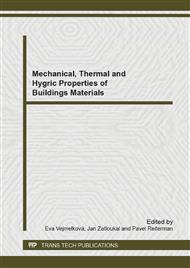[1]
J. Hegger, S. Voss, Investigations on the bearing behaviour and application potential of textile reinforced concrete, Engineering Structures Volume 30, 2008, pp.2050-2056, ISSN: 0141-0296.
DOI: 10.1016/j.engstruct.2008.01.006
Google Scholar
[2]
Information on http: /www. baunetzwissen. de.
Google Scholar
[3]
Information on http: /www. tu-dresden. de.
Google Scholar
[4]
J. Kratochvil, D. Mala, P. Stemberk and P. Reiterman, Design and construction of concrete canoe Blue lion", Proceedings of the International Conference on Modelling and Simulation 2010 in Prague (MS, 10), Prague, 2010, pp.256-259.
Google Scholar
[5]
W. Brameshuber, Textile Reinforced Concrete. RILEM Report 36, 2006 ISBN 2-912143-99-3.
Google Scholar
[6]
H. Michler, Segmentbrucke asu textilbewehrtem Beton – Rottachsteg Kempten im Allgau, Beton und Stahlbetonbau, Volume 108, Issue 5, 2013, DOI: 10. 1002/best. 201300023.
DOI: 10.1002/best.201300023
Google Scholar
[6]
Information on http: /www. groz-beckert. com.
Google Scholar
[7]
Information on http: /www. beton. org.
Google Scholar
[8]
H. M. Elsanadedy, T. H. Almusallam, S. H. Alsayed, Y. A. Al-Salloun, Flexural strengthening of RC beams using textile reinforced mortar – Experimental and numerical study, Composite Structures Volume 97, 2013, pp.40-55, ISSN: 0263-8223.
DOI: 10.1016/j.compstruct.2012.09.053
Google Scholar
[9]
F. Schladitz, M. Frenzel, D. Ehlig, M. Curbach, Bending load capacity of reinforced concrete slabs strengthened with textile reinforced concrete, Engineering Structures Volume 40, 2012, pp.317-326, ISSN: 0141-0296.
DOI: 10.1016/j.engstruct.2012.02.029
Google Scholar
[10]
A. Bruckner, R. Ortlepp, M. Curbach, Textile reinforced concrete for strengthening in bending and shear. RILEM, Materials and Structures, 2006, pp.714-748, DOI 10. 1617/s11527-005-9027-2.
DOI: 10.1617/s11527-005-9027-2
Google Scholar
[11]
Information on http: /www. heringinternational. com.
Google Scholar
[12]
Information on http: /downloads. german-pavilion. com/downloads/pdf/exhibitor27145. pdf.
Google Scholar
[13]
H. Funke, S. Gelbrich, L. Kroll, A New Hybrid Material of Textile Reinforced Concrete and Glass Fibre Reinforced Plastic, Journal of Materials Science Research, Vol. 2 No. 3, 2013, pp.96-101, ISSN: 1927-0585, E-ISSN 1927-0593.
DOI: 10.5539/jmsr.v2n3p96
Google Scholar
[14]
O. Holcapek, P. Reiterman and P. Konvalinka, High Temperatre Composite of Aluminous Cement with Addition of Metakaolin and Ground Bricks Dust, Experimental Stress Analysis 51. Uetikon-Zurich: Trans Tech Publications, 2014, pp.406-411.
DOI: 10.4028/www.scientific.net/amm.486.406
Google Scholar
[15]
P. Máca, R. Sovják, Resistance of ultrahigh performance fiber reinforced concrete to projectile impact. WIT Transactions on the Built Environment 126, pp.261-272. ISSN: 1743-3509.
DOI: 10.2495/su120231
Google Scholar


